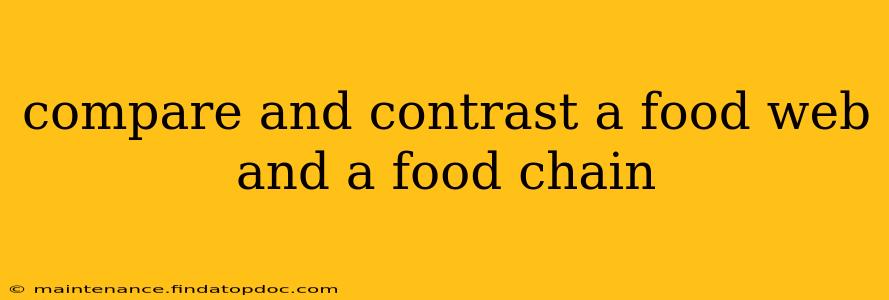Understanding how energy flows through an ecosystem is crucial to comprehending its health and stability. Two key concepts used to illustrate this flow are the food chain and the food web. While related, they offer different perspectives on the complex relationships within an ecosystem. This article will delve into the similarities and differences between these vital ecological concepts.
What is a Food Chain?
A food chain is a linear sequence illustrating the transfer of energy and nutrients from one organism to another. It shows a single pathway of energy flow, starting with a producer (like a plant) and moving through various trophic levels (consumer levels) to a top predator. For example, a simple food chain might look like this:
- Grass → Grasshopper → Frog → Snake → Hawk
In this chain, the grass is the producer, the grasshopper is the primary consumer (herbivore), the frog is the secondary consumer (carnivore), the snake is the tertiary consumer, and the hawk is the apex predator. Each organism is consumed by the next, transferring energy up the chain.
What is a Food Web?
Unlike a food chain's simplistic linear structure, a food web is a complex network showing the interconnected feeding relationships within an ecosystem. It illustrates multiple pathways of energy flow, acknowledging that many organisms occupy multiple trophic levels and have various food sources. A food web shows the intricate web of interactions between producers, consumers, and decomposers.
Comparing Food Chains and Food Webs: Key Differences
| Feature | Food Chain | Food Web |
|---|---|---|
| Structure | Linear | Complex network |
| Pathways | Single pathway of energy flow | Multiple pathways of energy flow |
| Organism Roles | Organisms occupy a single trophic level | Organisms can occupy multiple trophic levels |
| Complexity | Simple | Highly complex and interconnected |
| Realism | Oversimplified representation of nature | More accurate representation of ecosystem dynamics |
How are Food Chains and Food Webs Related?
Food chains are essentially simplified components of a food web. A food web can be visualized as a collection of interconnected food chains. Each individual chain within the web depicts a specific feeding relationship, but the web as a whole provides a much more complete and accurate picture of the ecosystem's structure.
What are the benefits of studying both food chains and food webs?
Studying both offers a comprehensive understanding of ecosystem dynamics. Food chains provide a basic framework for understanding energy flow, while food webs reveal the intricate complexities and interdependencies within an ecosystem. This helps ecologists understand the impact of changes within the ecosystem. For example, the removal of a key species in a food web could have cascading effects throughout the entire system, something that is less apparent in studying individual food chains.
What is the difference between a food web and an energy pyramid?
While closely related, a food web depicts the feeding relationships within an ecosystem, while an energy pyramid illustrates the flow of energy through those relationships. The pyramid shows how much energy is transferred between trophic levels, demonstrating the significant energy loss at each stage. Food webs provide the context within which energy pyramids function.
What are some examples of food webs in different ecosystems?
Food webs vary drastically depending on the ecosystem. A rainforest might have a vastly more complex food web than a desert due to the higher biodiversity. Examples include the intricate relationships within coral reefs, the complex interactions in temperate forests, or the simple yet vital connections in arctic tundra ecosystems. The specific organisms and their relationships differ significantly across these environments, creating unique food web structures.
How can I create a food web diagram?
Creating a food web diagram involves identifying the producers and consumers in an ecosystem and depicting the feeding relationships using arrows. Begin by identifying the producers (plants, algae) and then chart the consumers (herbivores, carnivores, omnivores) and their prey. Arrows indicate the direction of energy flow – from the organism being consumed to the organism consuming it.
By understanding both food chains and food webs, we gain a deeper appreciation for the intricate and interconnected nature of life on Earth. The combined study of these concepts provides valuable insights into the delicate balance of ecosystems and the vital role each organism plays within its environment.
